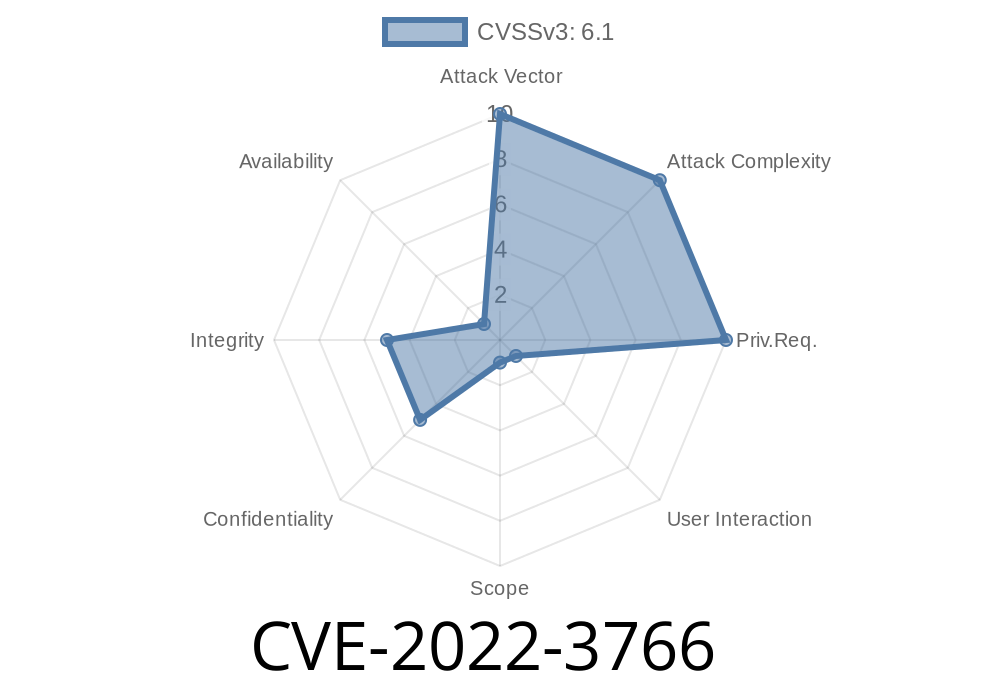A recently-discovered critical security vulnerability, known as CVE-2022-3766, affects the GitHub repository Thorsten/phpMyFAQ before version 3.1.8. This weakness is a type of Cross-Site Scripting (XSS) vulnerability, specifically Reflected XSS. In this comprehensive post, we will discuss the details of this vulnerability, provide a code snippet showcasing the issue, and offer valuable references to better understand the risks and potential exploits in the wild.
Background
Cross-site Scripting, or XSS, is a well-known web application security vulnerability. It allows malicious actors to inject client-side code, typically JavaScript, into web page views accessed by unsuspecting users. Reflected XSS, the specific type of XSS vulnerability in this case, means that the injected code gets executed immediately and is reflected on the results page upon user interaction, such as clicking a malicious URL.
When an application has a Reflected XSS vulnerability, it inadvertently includes user input as-is in the HTTP response, allowing the attacker to craft malicious URLs containing client-side code payloads that execute within the context of the user's web browser. This can lead to session hijacking, confidential data theft, defacement of websites, and other devastating consequences.
Code Snippet
The following code snippet is a simplified example of the Reflected XSS issue in the Thorsten/phpMyFAQ project:
<form action="search.php" method="post">
<input type="text" name="search" placeholder="Search...">
<input type="submit" value="Search">
</form>
<?php
if (isset($_POST['search'])) {
$search = $_POST['search'];
echo "Search results for: " . $search;
}
?>
In this example, the user input from the search parameter is being directly echoed without sanitizing or encoding it, which could lead to the execution of malicious client-side code if the input contains a payload like the following:
<script>alert('XSS!');</script>
Original References
Here are some links to original resources and articles that discuss CVE-2022-3766 and its implications in further detail:
1. CVE-2022-3766 - NVD: https://nvd.nist.gov/vuln/detail/CVE-2022-3766
2. GitHub Repository of Thorsten/phpMyFAQ: https://github.com/thorsten/phpMyFAQ
3. PHPMyFAQ Project: https://www.phpmyfaq.de/
4. OWASP's XSS Vulnerability Details: https://owasp.org/www-community/attacks/xss/
Exploit Details
Exploiting the CVE-2022-3766 vulnerability is rather straightforward. A malicious actor only needs to craft a malicious URL containing the payload, as shown below:
https://www.vulnerablewebsite.com/search.php?search=<script>alert('XSS!');</script>;
If an unsuspecting user clicks on this URL, their browser will load the payload and execute the JavaScript code, potentially allowing the attacker to steal their session, modify website content, or even redirect them to another malicious site.
To demonstrate the exploit, an attacker could send phishing emails containing the malicious URL to targeted users. Once these users click the link, their session cookies or other sensitive data might get stolen, compromising their accounts and enabling further unauthorized access.
Conclusion
CVE-2022-3766, a Reflected XSS vulnerability in the Thorsten/phpMyFAQ project, underscores the importance of web application security and proper input validation. Developers and administrators should take preventive measures, such as implementing content security policies, validating and sanitizing user inputs, and applying output encoding techniques to protect users from such exploits.
If you are using Thorsten/phpMyFAQ, it is essential to update to version 3.1.8 or newer to mitigate the risk associated with CVE-2022-3766. To stay updated on the latest security vulnerabilities and fixes, keep an eye on trusted sources, like the National Vulnerability Database (NVD), and watch for updates from the project maintainers.
Timeline
Published on: 10/31/2022 11:15:00 UTC
Last modified on: 11/01/2022 17:41:00 UTC
